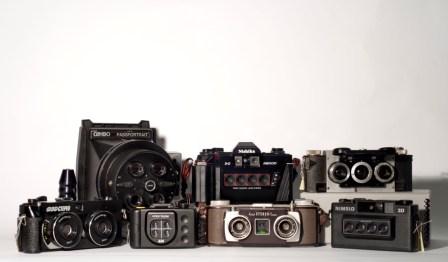There has been a continual trend in the yearning for the representation of truth and the real within photography, and seeing an image in three dimensions is the ultimate depiction of reality. In 1838, a year before Daguerre’s official announcement of the discovery of photography, Charles Wheatstone provided the scientific basis for stereoscopy, or 3-D imaging, showing how the brain operates to allow us to see in three dimensions. Stereoscopy led photographers one step closer to accurate representation of the real world by mimicking how our eyes function.
Stereographic cards contain two separate images of the same scene, but from slightly different viewpoints, printed next to each other and corresponding the spacing of the eyes. The left picture represents what the left eye would see and the right picture represents what the right eye would see. Viewed through a stereoscope, the pair of two-dimensional images merges together into a single three-dimensional photograph.
Following are are some of the stereo viewers and 3-D cameras from the Ryerson Library Special Collections.

The Holmes stereoscope is a later version of the original stereoscope from the 1840s but was the most common one from 1881 until 1939. The stereoscope is not a camera but is a device for viewing stereographic cards. Without a stereoscope, the viewer must cross or diverge his or her eyes so that a central, third three-dimensional image appears.

Stereoscopes were used in homes, schools, and churches, and covered every subject imaginable from astronomy to pornography.

Tru-Vue was a company that made binocular viewers and stereoscopic filmstrips. It began in 1931 and was purchased by Sawyer’s in 1951 – the manufacturer of the View-Master. Both the Tru-Vue and the View-Master were manufactured into the 1960s. Paired mounted slides, photographed on consumer cameras, are fed through the viewer, and, when held up to the light, the image appears in 3D.
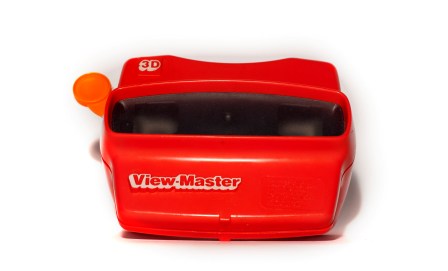
The View-Master is a device from the 1950s used to view stereo images mounted in a paper disk containing fourteen film slides in pairs (and thus seven three-dimensional images). Though the View-Master is now marketed to children, it was originally oriented toward adults as the slides included educational and tourism content.
By the 1920s, movies and other media supplanted stereoscopic images as the leading photographic medium. There was a resurgence of stereoscopy in the 1950s when stereo cameras were introduced to the public by a number of manufacturers.
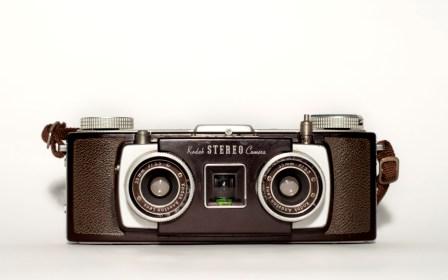
The Kodak Stereo camera was produced between 1954 and 1959. The dual lenses fire at the same time, creating an image for the right eye and one for the left. It was easy to use, allowing anyone to make their own 3-D photographs on 35mm slide film.

The Stereo Realist was the most popular 35mm stereo camera of all time. It was produced from about 1947 to 1971. It attracted celebrities throughout the 50s and its popularity continued on into the 60s. Harold Lloyd, a silent film star, formed a stereo camera club and was the most notable user of this camera. He shot portraits of celebrities such as Marilyn Monroe and Betty Page. Stereo advertisements of the time featured celebrities such as Vincent Price, John Wayne, Bob Hope, Joan Crawford, Doris Day, and Frank Capra, among others.
There was another revival of stereoscopy in the 1980s when point-and-shoot stereo cameras were introduced, but most suffered from poor optics and plastic construction, so they did not gain the popularity of the 1950s cameras.
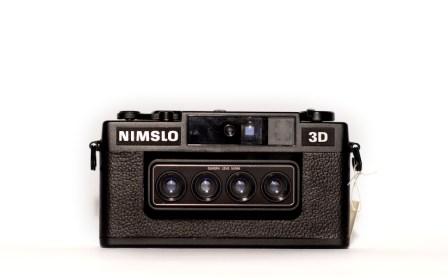
The Nimslo 3D camera was produced in 1982 by Nimstec and was the first consumer-level 3D camera of the 1980s that used 35mm film and that was easily portable. Four images are taken simultaneously, creating two 3D images per photograph. It was discontinued in 1990.
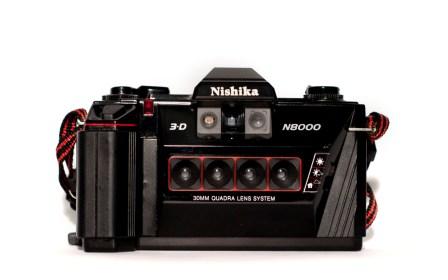
Nimslo went bankrupt and was sold to Nishika in 1989. They introduced the four-lens Nishika N8000, the first Nimslo clone. It features a plastic body with plastic lenses, a fixed shutter speed, and 3 aperture settings. It is also focus-free. It uses standard 35mm film and creates lenticular images, which do not require a special viewer to see the 3D image. Four photos are taken simultaneously from four slightly different angles.
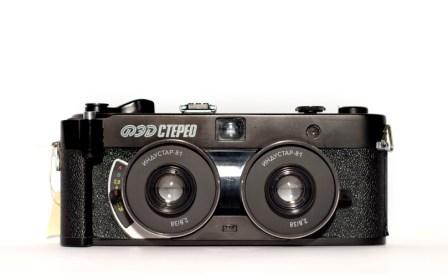
The FED Ctepeo is a Russian stereo camera. It uses standard 35mm film to produce two images of 24x30mm per exposure.
As an impressive and entertaining illusion, stereoscopy quickly became an ongoing trend and the technique is still catching people’s eyes today!
If you would like more information on any of the special collections in the Ryerson Library please drop by the 4th floor of the library, or make an appointment: asc@ryerson.ca. You can search our collection online here.
References:
FED (Camera). (2012, April 17). In Wikipedia: The Free Enclyclopedia. Retrieved July 20, 2012, from http://en.wikipedia.org/wiki/FED_(camera).
Kodak Stereo Camera (2012, February 9). In Wikipedia: The Free Enclyclopedia. Retrieved July 20, 2012, from http://en.wikipedia.org/wiki/Kodak_Stereo_Camera.
Nimslo. (2012, April 13). In Wikipedia: The Free Enclyclopedia. Retrieved July 20, 2012, from http://en.wikipedia.org/wiki/Nimslo.
Spiro, L. (2006, October 30). A Brief History of Stereographs and Stereoscopes. Connexions. Retrieved July 20, 2012, from http://cnx.org/content/m13784/latest/.
Stereo Realist. (2912, April 7). In Cameraopedia. Retrieved July 20, 2012, from http://camerapedia.wikia.com/wiki/Stereo_Realist.
Stereoscope. (n.d.). In Laura Hayes and John Howard Wileman Exhibit of Optical Toys. Retrieved July 6, 2016, from http://courses.ncssm.edu/gallery/collections/toys/opticaltoys.htm.
Stereoscopy. (2012, July 17). In Wikipedia: The Free Enclyclopedia. Retrieved July 20, 2012, from http://en.wikipedia.org/wiki/Stereoscopy.
Tru-Vue. (2012, April 30). In Wikipedia: The Free Enclyclopedia. Retrieved July 20, 2012, from http://en.wikipedia.org/wiki/Tru-Vue.
View-Master. (2012, July 16). In Wikipedia: The Free Enclyclopedia. Retrieved July 20, 2012, from http://en.wikipedia.org/wiki/View-Master.
